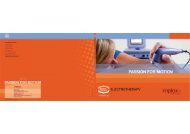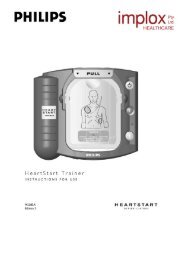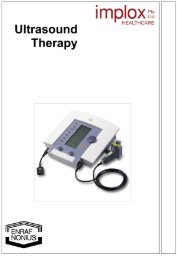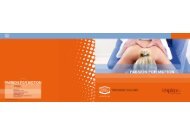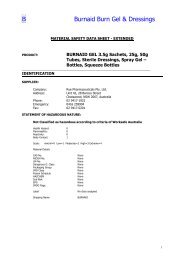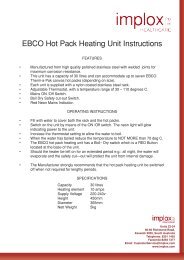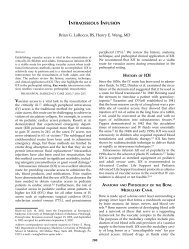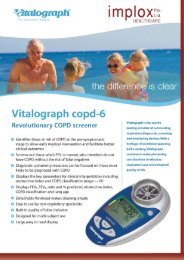Low and medium Frequency Electrotherapy - Implox
Low and medium Frequency Electrotherapy - Implox
Low and medium Frequency Electrotherapy - Implox
Create successful ePaper yourself
Turn your PDF publications into a flip-book with our unique Google optimized e-Paper software.
The second function of SP is to stimulate the production of specialized contractile fibroblasts known as<br />
myofibroblasts, resulting in contraction of the wound area.<br />
It can therefore be stated that SP has a tissue-restoring effect. In a disrupted wound healing process there is<br />
apparently no liberation of SP.<br />
Electrostimulation affects the disrupted wound healing process in two ways:<br />
1. Electrostimulation leads to antidromic stimulation of the sensory nerves, causing release of SP at the peripheral<br />
nerve endings (17) (Fig. 33).<br />
2. The electric current influences the capillaries in the wound bed. Sprouting of these capillaries provides a good<br />
supply of nutrients, encouraging the laying-down of granulation tissue.<br />
8.3 Wound healing in practice<br />
Direct current <strong>and</strong> TENS current types appear to have a favourable effect on wound healing.<br />
8.3.1 Direct current<br />
When direct current is applied, a low amplitude is set (0.1-1.0 mA/cm²).<br />
Some remarks are required with respect to the polarity:<br />
• skin naturally has a negative charge. If the skin is injured, the damaged area will have a positive charge with<br />
respect to the undamaged surroundings<br />
• application of an anode in or on the wound encourages the laying-down of granulation tissue, but will also<br />
exacerbate any bacterial infection that may be present<br />
• application f a cathode in or on the wound will retard the laying-down of granulation tissue, but also has a marked<br />
bactericidal effect (35) .<br />
On the basis of the foregoing, the following guidelines can be followed (4,31) . During the first three days a negative<br />
electrode is applied on or near the skin lesion. Each treatment lasts for two hours, <strong>and</strong> is carried out two to six times<br />
per day. After three days, provided that no sepsis is present, a positive electrode is applied.<br />
If the wound is deep, a sterile gauze soaked in distilled water or physiological saline solution should be placed in the<br />
wound, with the active electrode over it. The inactive electrode should be placed ca. 25 cm proximal to the lesion.<br />
When a continuous direct current is used, the amplitude is set between 0.2 <strong>and</strong> 0.8 mA.<br />
For (objective) assessment of the results of treatment, it is advisable to:<br />
• measure the area of the wound;<br />
• measure or assess the depth of the wound;<br />
• identify any micro-organisms present;<br />
• describe any other aspects of the wound;<br />
• photograph the wound (before the start of electrostimulation, <strong>and</strong> once a week thereafter);<br />
• record the results after each treatment session.<br />
8.3.2 TENS current types<br />
TENS current types can also be used to promote wound healing (12,20) (Fig. 33). Lundeberg (20) used an alternating<br />
rectangular pulse with a variable phase duration of 0.2-1.0 ms for the treatment of diabetic ulcus cruris, arterial <strong>and</strong><br />
venous ulcers, <strong>and</strong> post-operative wounds (skin flap operation).<br />
For initial treatment of diabetic, arterial <strong>and</strong> venous ulcers, a phase duration of 1.0 ms <strong>and</strong> a frequency of 50 Hz are<br />
selected. The amplitude should be sufficient to give a strong tingling sensation (sensory to motor stimulation level). If<br />
this is too painful for the patient, or if severe skin irritation occurs, the phase duration can be shortened down to 0.2<br />
ms. As a symmetrical alternating current is used, the polarity is unimportant. The electrodes are applied as follows:<br />
a. If the sensitivity of the affected region is intact, one electrode is placed proximal to the lesion, <strong>and</strong> the other distal,<br />
as close as possible to the edges of the lesion.<br />
b. If the sensitivity in the region is impaired, both electrodes are placed proximal to the lesion in an area where the<br />
sensibility is still intact.<br />
The duration of each treatment session 20-30 (60) minutes, <strong>and</strong> treatment is carried out twice daily with an interval of<br />
six hours.<br />
For treatment of post-operative wounds such as ischaemic skin flaps, a phase duration of 0.4 ms <strong>and</strong> a frequency of<br />
80 Hz are selected. The duration of each treatment session is two hours, <strong>and</strong> treatment is carried out twice daily.<br />
36



